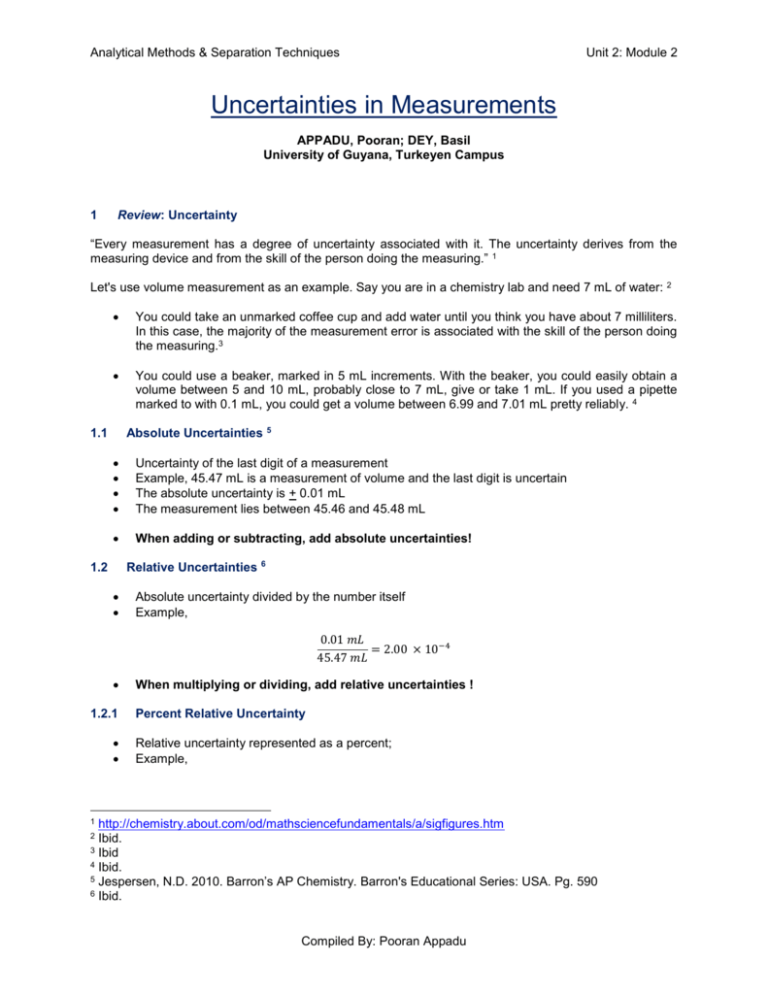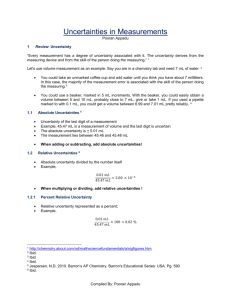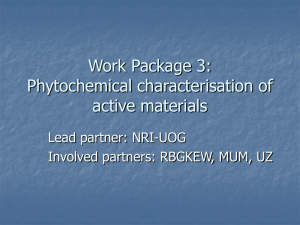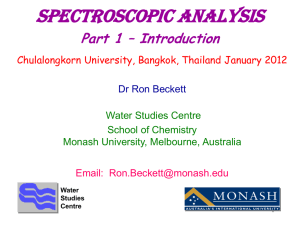Uncertainities in Measurements
advertisement

Analytical Methods & Separation Techniques Unit 2: Module 2 Uncertainties in Measurements APPADU, Pooran; DEY, Basil University of Guyana, Turkeyen Campus 1 Review: Uncertainty “Every measurement has a degree of uncertainty associated with it. The uncertainty derives from the measuring device and from the skill of the person doing the measuring.” 1 Let's use volume measurement as an example. Say you are in a chemistry lab and need 7 mL of water: 2 You could take an unmarked coffee cup and add water until you think you have about 7 milliliters. In this case, the majority of the measurement error is associated with the skill of the person doing the measuring.3 You could use a beaker, marked in 5 mL increments. With the beaker, you could easily obtain a volume between 5 and 10 mL, probably close to 7 mL, give or take 1 mL. If you used a pipette marked to with 0.1 mL, you could get a volume between 6.99 and 7.01 mL pretty reliably. 4 Absolute Uncertainties 5 1.1 Uncertainty of the last digit of a measurement Example, 45.47 mL is a measurement of volume and the last digit is uncertain The absolute uncertainty is + 0.01 mL The measurement lies between 45.46 and 45.48 mL When adding or subtracting, add absolute uncertainties! Relative Uncertainties 6 1.2 Absolute uncertainty divided by the number itself Example, 0.01 𝑚𝐿 = 2.00 × 10−4 45.47 𝑚𝐿 1.2.1 When multiplying or dividing, add relative uncertainties ! Percent Relative Uncertainty Relative uncertainty represented as a percent; Example, 1 http://chemistry.about.com/od/mathsciencefundamentals/a/sigfigures.htm Ibid. 3 Ibid 4 Ibid. 5 Jespersen, N.D. 2010. Barron’s AP Chemistry. Barron's Educational Series: USA. Pg. 590 6 Ibid. 2 Compiled By: Pooran Appadu Analytical Methods & Separation Techniques Unit 2: Module 2 0.01 𝑚𝐿 × 100 = 0.02 % 45.47 𝑚𝐿 2 Review: Significant Figures “All measurements are approximations—no measuring device can give perfect measurements without experimental uncertainty. By convention, a mass measured to 13.2 g is said to have an absolute uncertainty of plus or minus 0.1 g and is said to have been measured to the nearest 0.1 g.” 7 The number of significant figures in a result is simply the number of figures that are known with some degree of reliability. The number 13.2 is said to have 3 significant figures. The number 13.20 is said to have 4 significant figures. 8 2.1 Rules for deciding the number of significant figures in a measured quantity: (1) All nonzero digits are significant: 1.234 g has 4 significant figures 1.2 g has 2 significant figures. (2) Zeroes between nonzero digits are significant: 1002 kg has 4 significant figures, 3.07 mL has 3 significant figures (3) Leading zeros to the left of the first nonzero digits are not significant; such zeroes merely indicate the position of the decimal point: oC has only 1 significant figure, 0.012 g has 2 significant figures. (4) Trailing zeroes that are also to the right of a decimal point in a number are significant: 0.0230 mL has 3 significant figures, 0.20 g has 2 significant figures. (5) When a number ends in zeroes that are not to the right of a decimal point, the zeroes are not necessarily significant: 190 miles may be 2 or 3 significant figures, 50,600 calories may be 3, 4, or 5 significant figures. The potential ambiguity in the last rule can be avoided by the use of standard exponential, or "scientific," notation. For example, depending on whether the number of significant figures is 3, 4, or 5, we would write 50,600 calories as: 7 8 5.06 × 104 calories (3 significant figures) 5.060 × 104 calories (4 significant figures), or 5.0600 × 104 calories (5 significant figures). http://www.chem.sc.edu/faculty/morgan/resources/sigfigs/index.html Ibid. Compiled By: Pooran Appadu Analytical Methods & Separation Techniques Unit 2: Module 2 By writing a number in scientific notation, the number of significant figures is clearly indicated by the number of numerical figures in the 'digit' term as shown by these examples. Rules for Mathematical Operations 9 2.2 Addition & Subtraction Another way to state this rule is as follows: in addition and subtraction, the result is rounded off so that it has the same number of digits as the measurement having the fewest decimal places (counting from left to right). For example, 100 (assume 3 significant figures) + 23.643 (5 significant figures) = 123.643, should be rounded to 124 (3 significant figures). Note: however, that it is possible two numbers have no common digits (significant figures in the same digit column). ??? Multiplication & Division The result should be rounded off so as to have the same number of significant figures as in the component with the least number of significant figures. For example, 3 3.1 3.0 (2 significant figures ) × 12.60 (4 significant figures) = 37.8000 Which should be rounded to 38 (2 significant figures). More Important Terms and Concepts Mean “is the central tendency of a collection of numbers taken as the sum of the numbers divided by the size of the collection” 10 𝑛 1 𝑥̅ = ∑ 𝑎𝑖 𝑛 𝑖=1 Question 1. Richards & Willard (1910) determined the atomic mass of Lithium and collected the following data: 11 Exp’t 1 2 3 4 5 6 7 Molar Mass (g/mol) 6.9391 6.9407 6.9409 6.9399 6.9407 6.9391 6.9406 (a) Find the mean atomic mass determined. 9 Ibid. http://en.wikipedia.org/wiki/Mean 11 Skoog, D., et al., (2004). Fundamentals of Analytical Chemistry 8th Edition. USA: Thomson Publishers 10 Compiled By: Pooran Appadu Analytical Methods & Separation Techniques Unit 2: Module 2 2. Find the mean of the following sets of data: (a) 0.0110 (b) 4.52 x 10-3 3.2 0.0104 4.47 x 10-3 12 0.0105 4.63 x 10-3 4.48 x 10-3 4.58 x 10-3 4.53 x 10-3 Standard Deviation “The mean does a nice job in telling where the center of the data set is. However, consider that a pharmaceutical engineer develops a new drug that regulates iron in the blood. She finds out that the average sugar content after taking the medication is the optimal level. This does not mean that the drug is effective. There is a possibility that half of the patients have dangerously low sugar content while the other half have dangerously high content. Instead of the drug being an effective regulator, it is a deadly poison. What the pharmacist needs is a measure of how far the data is spread apart. For this, the standard deviation comes in handy.”13 The standard deviation is defined as: n s=√ 1 ∑(x − x̅)2 n−1 i=1 Example “The owner of the Ches Tahoe restaurant is interested in how much people spend at the restaurant. He examines 10 randomly selected receipts for parties of four and writes down the following data.” 14 44, 50, 38, 96, 42, 47, 40, 39, 46, 50 (a) Calculate the mean 𝐱̅ = 44 + 50 + 38 + 96 + 42 + 47 + 40 + 39 + 46 + 50 = 49 10 (b) Calculate the standard deviation 𝐱 44 50 38 96 42 47 40 39 46 50 𝐱 − 𝐱̅ -5.2 0.8 11.2 46.8 -7.2 -2.2 -9.2 -10.2 -3.2 0.8 Total (𝐱 − 𝐱̅)𝟐 27.04 0.64 125.44 2190.24 51.84 4.84 84.64 104.04 10.24 0.64 2600.40 12 Ibid. http://www.ltcconline.net/greenl/courses/201/descstat/mean.htm 14 Ibid. 13 Compiled By: Pooran Appadu Analytical Methods & Separation Techniques Unit 2: Module 2 2600.40 s = √( ) = 17.00 9 The standard deviation can be thought of measuring how far the data values lie from the mean, we take the mean and move one standard deviation in either direction. (c) Calculate x̅ ± s Upper: 49.20 + 17.00 = Lower: 49.20 − 17.00 = Question 15 A laboratory technician analyses water samples for degree of hardness, which is expressed in parts per million (ppm) of calcium carbonate. The results are given below: Sample # 1 2 3 4 5 6 7 8 9 10 CaCO3, ppm 250 245 265 300 225 230 248 295 235 220 Table 1 – Degree of Hardness of Water Samples16 (a) Calculate mean and standard deviation of the values (4 marks) (b) What does the standard deviation value indicate about the variability in the degree of hardness? (1 mark) (c) The ten samples of water are taken from ten different sites. How can the reliability of the data obtained from each sample be improved? (1 mark) 3.3 Precision & Accuracy Precision: “Describes the agreement among several results obtained in the same way. Precision can be determined by measuring replicate samples.” 17 Accuracy: “Indicates the closeness of the measurement to the true or accepted value. Accuracy is more often difficult to determine because the true value is usually unknown. An accepted value must be used instead.”18 15 CXC. 2005. CAPE Chemistry Unit 1 Module 3. CXC. 2005. CAPE Chemistry Unit 1 Module 3. 17 Skoog, D., et al., 2004. Fundamentals of Analytical Chemistry 8th Edition. USA: Thomson Publishers. Pg. 93 18 Ibid, Pg. 93 16 Compiled By: Pooran Appadu Analytical Methods & Separation Techniques Unit 2: Module 2 Figure 1 – Illustration of Accuracy and Precision using the patter of darts on a Dartboard 3.4 19 Calibration Curves “A calibration curve is a general method for determining the concentration of a substance in an unknown sample by comparing the unknown to a set of standard samples of known concentration” 20 3.4.1 Characteristics of a Calibration Curve Figure 2 – A calibration curve plot showing limit of detection (LOD), limit of quantification (LOQ), dynamic range, and limit of linearity (LOL) 21 LOD: 22 19 Skoog, D., et al., 2004. Fundamentals of Analytical Chemistry 8th Edition. USA: Thomson Publishers. http://en.wikipedia.org/wiki/Calibration_curve 21 Ibid 22 http://en.wikipedia.org/wiki/Detection_limit 20 Compiled By: Pooran Appadu Analytical Methods & Separation Techniques Unit 2: Module 2 lowest quantity of a substance that can be distinguished from the absence of that substance (a blank value) within a stated confidence limit LOD defined as 3 x standard deviation of the blank LOQ 23 The LOQ is the limit at which we can reasonably tell the difference between two different values. 10 * standard deviation of the blank; Dynamic Range LOQ to LOL Sensitivity 24 Smallest change in amount we can see with a known level of confidence. Often based on smallest change that an instrument can display LOL 3.5 Point where the calibration curve departs from linearity Standards “Standards are materials containing a known concentration of an analyte. They provide a reference to determine unknown concentrations or to calibrate analytical instruments. The accuracy of an analytical measurement is how close a result comes to the true value. Determining the accuracy of a measurement usually requires calibration of the analytical method with a known standard. This is often done with standards of several concentrations to make a calibration or working curve.” 25 3.5.1 Primary Standards “A primary standard is typically a reagent which can be weighed easily, and which is so pure that its weight is truly representative of the number of moles of substance contained. Features of a primary standard include:” 26 1. 2. 3. 4. 5. 6. 7. 3.5.2 High purity Stability (low reactivity) Low hygroscopicity and efflorescence High solubility (if used in titration) High equivalent weight Non-toxicity Ready and cheap availability Secondary Standards A secondary standard is a standard that is prepared in the laboratory for a specific analysis. It is usually standardized against a primary standard. 23 http://en.wikipedia.org/wiki/LOQ http://ull.chemistry.uakron.edu/chemometrics/07_Calibration.pdf 25 http://www.files.chem.vt.edu/chem-ed/data/standard.html 26 http://en.wikipedia.org/wiki/Primary_standard 24 Compiled By: Pooran Appadu Analytical Methods & Separation Techniques 4 Unit 2: Module 2 Degree of Uncertainty 4.1 Pipettes A pipette (also called a pipet, pipettor, or chemical dropper) is a laboratory tool used to transport a measured volume of liquid. Pipettes are used to measure small volumes of fluid: 1 2 3 5 10 20 25 50 100 Both the maximum capacity and the size of the increments are printed on the end of the pipette. 27 Question: Precision and Accuracy of a 25 mL Pipette Three chemistry majors at the University of Guyana performed the following experiment in their Analytical Chemistry II laboratory session: A pipette was used to measure 25 mL of water; A beaker was placed on an analytical balance and tared; The water in the pipette was poured into the beaker and the mass (4 dp) was recorded. Each student did 4 replicates and the results are as follows: Mass, g Recorded by Student #1 24.8043 Mass, g Recorded by Student #2 24.8067 Mass, g Recorded by Student #3 24.7123 24.8086 24.8162 24.7396 24.8102 24.8194 24.7403 24.8160 24.8228 24.7512 Note: the original experiment was done by eight students and twelve replicates were recorded, however, statistical analyses were performed using software packages. (a) Assuming that the density of water at 30 oC = 0.9957 g/cm3 AND assume that the balance has been calibrated, convert the mass (g) to volume (mL) (b) Calculate the mean and standard deviation of the results for each student. (c) Comment on the accuracy (Vo = 25 mL) and precision of the pipette (Hint: consider standard deviation); Question28 - A typical CAPE Exam question The table below shows the readings obtained during the calibration of a 25 cm 3 pipette. During the calibration exercise the masses of 25 cm 3 samples of water were recorded. The volumes of the 27 Lab Math: A Handbook of Measurements, Calculations, and Other Quantitative Skills for Use at the Bench 28http://fmcapechemistry.weebly.com/uploads/5/6/3/3/5633072/unit_2_chem_lessons_mod_2_titrimetric_ analyses.doc Compiled By: Pooran Appadu Analytical Methods & Separation Techniques Unit 2: Module 2 equilibrated water used were then determined using the density of water with a correction for buoyancy error. Sample 1 2 3 4 5 6 7 8 9 10 Volume, cm3 25.008 25.006 25.017 25.010 25.009 25.015 25.007 25.008 25.015 25.006 (a) Calculate the mean, standard deviation of the volumes delivered by the pipette. (4 marks) (b) State the capacity of the pipette (1 mark) (c) What additional measurements would have been necessary for the conversion of mass to volume? Explain your answer. (2 marks) Correction 4.1.1 Types of Pipettes Volumetric or Bulb Pipettes29 Consist of a long glass tube with a central cylindrical bulb Single graduation mark is etched around the upper end of the tube Lower end of the tube is drawn into a fine tip A fixed volume of liquid is delivered such as 1, 2, 5, 10, 20, 25, 50, 100 mL 10, 25, 50 mL commonly used Also known as : Transfer pipettes and One Mark pipettes 29 Prichard, E & Lawn, R. 2003. Practical Laboratory Skills Training Guides: Measurement of Volume. Royal Society of Chemistry: United Kingdom Compiled By: Pooran Appadu Analytical Methods & Separation Techniques Unit 2: Module 2 Figure 3 30 Graduated Pipettes Consist of a long glass tube, but no central bulb Carries graduation marks, enabling a range of volumes to be delivered; Typical capacities: 1 – 25 mL with graduations of 0.01 mL to 0.2 mL They are not as accurate as BULB pipettes; Mainly used for dispensing pre-determined volumes where the highest possible accuracy is not required; For variable volume dispensing of a higher accuracy than is attainable using a graduated pipette, a burette should be used instead! Types: (i) Type 1 and Type 2 o o Type 1 (Mohr) delivers a measured volume from a top zero mark to a selected graduation mark Type 2 (Serological) delivers a measured volume from a selected graduation mark to the jet, which forms the zero mark. The residual liquid may need to be expelled, in which case the pipette will be marked “blow out” Figure 4 – A mohr pipette31 30 31 http://www.hoskin.ca/catalog/images/Volumetric%20Pipette.jpg http://www.uwplatt.edu/chemep/chem/chemscape/labdocs/glossary/pic/anmohr.gif Compiled By: Pooran Appadu Analytical Methods & Separation Techniques Unit 2: Module 2 Figure 5 – A serological pipette 32 Burettes 33 4.2 Used to dispense controlled small amounts of a liquid with great precision; Used to perform titrations for quantitative analyses; Used to determine accurate concentrations of stock solutions; Available in glass and plastic o Glass are easy to clean; o Unaffected by organic solvents; Capacity : 50 mL, 100 mL are common; o Flexibile o Accurate Values are reported as : o 25.00 + 0.10 mL Volumetric Flasks 34 4.3 Used to make up a precise volume of solution One graduation line that indicates the ‘nominal’ volume Typical procedure o Partially fill with water o Add chemicals o Swirl until dissolved o Fill the flask to the graduation line Designed to be accurate at 20 oC Small variations do not affect accuracy If making up solutions that are endothermic or exothermic, wait until they cool to room temperature, then make up to mark MOST volumetric flasks are made of ‘flint glass’. Others are made of Pyrex or Borosilicate. o Initially dissolve exothermic solutes in a beaker or conical flask o After the solution is cool, transfer to the volumetric flask o Rinse the beaker or conical flask into the volumetric flask; o Make up to mark o Also known as a Quantitative transfer 32 http://www.thesciencefair.com/Merchant2/graphics/00000001/SerologicalPipets_3877_M.jpg Thompson, RB & Thompson, BF. 2012. Illustrated Guide to Home Chemistry Experiments: All Lab, No Lecture. : USA 34 Ibid. 33 Compiled By: Pooran Appadu Analytical Methods & Separation Techniques Unit 2: Module 2 Labs typically have: 25, 50, 100, 250, 500, 1 L, 2 L flasks Flint Glass: is a type of glass known for its high transparency and refractive value 35, Pyrex: low-thermal-expansion borosilicate glass36 Borosilicate Glass: is a type of glass with the main glass-forming constituents silica and boron oxide37 Top Loading Balances38 4.4 Used to weigh solid material when a precision of 0.1 g is adequate; For more accurate mass measurements or small amounts, use an analytical balance Figure 6 39 Analytical Balances40 4.5 Measures masses to within 0.0001 g. Use these balances when you need this high degree of precision. 35 www.wisegeek.com/what-is-flint-glass.htm http://en.wikipedia.org/wiki/Pyrex 37 http://en.wikipedia.org/wiki/Borosilicate_glass 38 http://www.dartmouth.edu/~chemlab/techniques/top_balance.html 39 http://mettler-toledo.centralcarolinascale.com/PL-Balance.htm 40 http://www.dartmouth.edu/~chemlab/techniques/a_balance.html 36 Compiled By: Pooran Appadu Analytical Methods & Separation Techniques Unit 2: Module 2 Figure 7 41 Thermometers42 4.6 Traditional “tube thermometer” is a glass tube with a narrow bore and a bulb on one end, filled with a fluid that expands and contracts with changes in temperature; Mercury is being replaced by dyed alcohol or similar fluids; Alcohol filled thermometers (spirit thermometers) are as accurate at Hg thermometers, BUT are limited to measuring a smaller temperature range (-20 oC to 150 oC) In contract, Hg thermometers have an upper range of +250 oC. Standard length thermometers with very wide ranges have lower resolutions: o For example, a thermometer with a very wide range might have 2 oC gradations whilst a similar thermometer with a narrower range might have 1 oC gradations. o 1 oC is suitable for typical lab work; TWO classes of tube thermometers: o Partial immersion thermometer o Full immersion thermometer Partial immersion, more common, does not to be fully immersed in the liquid being measured, typically 3” is sufficient; Full immersion thermometers, on the other hand, needs to be submerged to the level of the indicator fluid; o For example, if the full immersion thermometer reads 50 oC, the thermometer should be submerged until the level of the liquid being tested is at the 50 oC mark on the thermometer; 41 http://www.sysmatec.ch/Images/KERNABT.jpg Prichard, E & Lawn, R. 2003. Practical Laboratory Skills Training Guides: Measurement of Volume. Royal Society of Chemistry: United Kingdom 42 Compiled By: Pooran Appadu





